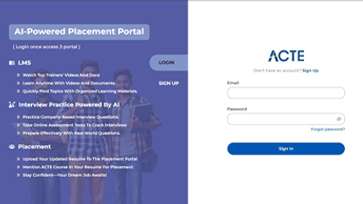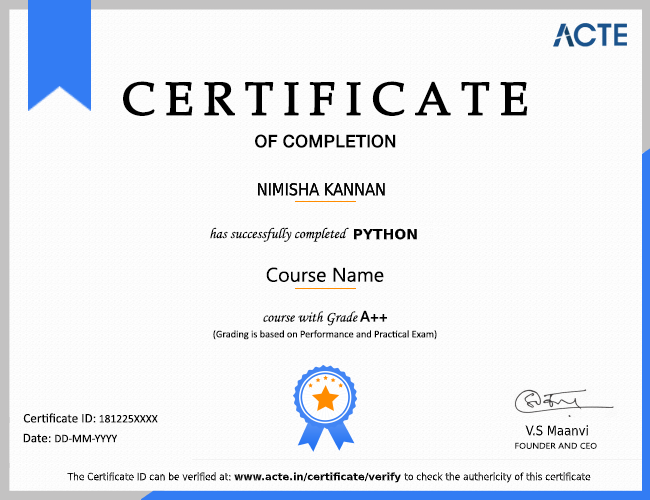MEAN Stack is the combination of MongoDB Express JS AngularJS, Node JS. These four are mainly used for a database system, back-end runtime and framework, and front-end framework. If you are going to be a developer but if you learn HTML/CSS or bootstrap you will become as a front-end developer, if you pursue dotnet, PHP, Java course you will become as a back-end developer.Start learning with us ACTE MEAN STACK Classroom & Online Training Course.
- MEAN Stack is one of the most popular web development models. Many companies are adopting MEAN Stack because it is open source and flexible.
- There are about 2.5Million+ career opportunities available on this technology in the market.
- The MEAN stack developers earn an average of $82,800 USD per annum. Based on experience, it may extend up to $121000 USD per annum.
Most of the organizations are on the brink of using Mean Stack technology for developing web applications. As it’s basic architecture is built on MEAN Stackscript technologies, it uses the same code for the client as well as on the server side.Due to this characteristic, it is a simple language and saves time in web application development.By leaning the MEAN stack(MEAN StackScript technologies), you’ll have a wide range of domains to choose from. Web, mobile, desktop and even IoT, because all these frameworks are built on top of MEAN StackScript you can easily hop between frameworks, provided you have a good understanding of MEAN StackScript.Career wise you have good opportunities in a lot of domains, every other company has to deal with MEAN StackScript some or the other day.
As per the industry stats, most hiring is happening for the below roles:
- Web developers
- Entrepreneurs
- Technical leads
- Technical project managers
YES,MEAN STACK Development is booming field in Web development.A meanstack develeoper is also known as fullstack developer because they can do both front end and back end development.So, If you are MEAN STACK developer then you can create the both ends. You not need the other developer for front end or back end. So there are good opportunity in future if you have good knowledge about MEAN STACK. Also your company will pay you more because you are two face(Front end + Back End) in one person.
We are happy and proud to say that we have strong relationship with over 700+ small, mid-sized and MNCs. Many of these companies have openings for MEAN Stack.Moreover, we have a very active placement cell that provides 100% placement assistance to our students. The cell also contributes by training students in mock interviews and discussions even after the course completion.
Full stack is development of a web application from front to back, including front end, backend and Database. MEAN Stack is a set of technologies that you can use to make a full stack application.
Basic MEAN StackScripts,HTML/HTML 5,Css, IDE (like Webstorm)knowledge is sufficient to pursue this MEAN Stack training.
NO,Absolutely it is necessary to know MEAN StackScripts,HTML/HTML 5,Css to master MEAN Stack
Our courseware is designed to give a hands-on approach to the students in MEAN Stack. The course is made up of theoretical classes that teach the basics of each module followed by high-intensity practical sessions reflecting the current challenges and needs of the industry that will demand the student's time and commitment.
Yes,MEAN Stack has become an essential web technology along with HTML and CSS, as most browsers implement MEAN StackScript.Furthermore, MEAN Stackusage has now extended to mobile app development, desktop app development, and game development. All in all, it has exploded in popularity and is now a very useful skill to learn.
Some benefits are as follows:
- It is estimated that a well-versed MEAN Stack developer can get paid an average of $121000 USD per annum.
- Individuals have multiple career options to choose from like, Web Developers, Computer and Mathematical occupations, etc.
- There is no need for knowledge of multiple languages, since they write the whole code in MEAN StackScript language.
- There is a higher rate of employment.
MEAN Stackis a vital area of many IT job roles and gaining the applicable expertise and passing MEAN Stack exams in this area will greatly enhance your employability.
Its better to select ACTE which comprises these below factors.
- Appropriate training with well Equipped facilities.
- Technical MEAN Stack certifications
- Complete knowledge in the MEAN Stack
- Technical theory
- Mock Interviews
In software development terms, “Stack” is a combination of different software products and programming languages to create web or mobile applications. Nowadays, software firms are implementing the strategy of using a combination of various technologies to enable faster and more dynamic web development process.MEAN is an acronym, which stands for MongoDB (database system), ExpressJS (back-end web framework), AngularJS (front-end framework) and NodeJS (back-end runtime environment). These technologies were developed at different points of time. But, today they are grouped together to form the MEAN stack and the reason is pretty clear. It is MEAN StackScript that binds them together. MEAN StackScript is a dynamic programming language for client-side and server-side web application development.
Here are a few reasons for you to pursue a career in MEAN Stack:
- Hands-on engagement with the best-Engineering platform in human history.
- A sense of mission and higher purpose
- The emergence of agile MEAN StackDevelopers(Web Development)
- Enterprise applications are multiplatform/Web designing/Web development
- community support and training.
- Build a lucrative career.
Career opportunities in Mean Stack:
In this blog, we are going to learn all about MEAN stack and the different technologies used in it. We will start with the introduction to MEAN, and then we will dive deep into it for understanding what MongoDB, Express.js, Angular.js, and Node.js are. Once we learn all about MEAN stack, we will move ahead and answer the questions: ‘Who is a MEAN Stack Developer? and ‘What is the scope of MEAN Stack?'
MEAN is a collection of technologies ( MongoDB, Express.js, Angular.js and Node.js) associated with JavaScript, which is used to build web-based applications. MEAN stack is responsible for the development of each component of website development from client-side/server-side to database handling, and all these are based on one technology, i.e., JavaScript. MEAN stack is a branch of full-stack development that is used by developers in building fast and powerful web-based applications.
If we want to build a dynamic website, then MEAN stack is an ideal choice for us and the reason is simple: MEAN is user-friendly. On top of it all, the technology of MEAN stack is open-source, i.e., free to use; with the help of MEAN stack, we can make prototypes for our website very quickly and organize our website easily.
Technologies That Come Under MEAN
- MongoDB:It handles the database of web applications.
- js:It is a Node.js framework used to build APIs for web applications.
- js:It is a frontend development framework majorly maintained by Google.
- js:It is used to handle the server-side.
Now that we know about MEAN stack, let’s further see each of its components in detail. We will start with MongoDB, and then we will learn the different versions of it, why it is used in MEAN, and much more.
What is MongoDB?
MongoDB is written in C++ and it is an open-source, multi-platform database. In MongoDB, the storage of data (in key-value pairs) is more flexible than the other databases, and here the type of data stored is binary like JSON.
MongoDB is a document-oriented NoSQL database, i.e., the fields can vary from document to document and the data structure can be changed over time. A document in MongoDB resembles an object in OOPS.
If we are having large tables with a huge amount of data (up to millions), then we can manage them easily with the help of MongoDB. Inserting new fields to MongoDB is very easy because it won’t update the entire table if we insert new data fields, which makes MongoDB an ideal choice for a database system. Moreover, with MongoDB, we can build a whole web application by using just one scripting language, JavaScript, and that’s the biggest advantage of all.
What is Express js?
Express.js, a mature, flexible, and lightweight server framework, is used for the server-side applications. With the help of Express.js, we can build single-page, multi-page, or hybrid web applications. Express is also written in JavaScript. To provide support for templates, it uses the Pug engine (one of the most popular templating engines).
Express is a framework for Node.js. It has drawn heavy inspiration from Sinatra, the popular Ruby framework.
In this blog, now, we will check out some of the core features of Express.js.
Core Features of the Express.js Framework
- As mentioned, Express can be used to design single-page, multi-page, or hybrid web applications.
- It allows developers to set up middlewares to respond to HTTP requests.To perform different actions based on the HTTP method and the URL, Express defines a routing table.
- We can dynamically render HTML pages by passing arguments to templates with the help of Express.
Why should we use Express.js?
- Express is an ultra-fast I/O. As a server-side language, we expect it to be fast and it is.
- Express is asynchronous and single-threaded.
- It has an MVC (Model–View–Controller) like structure.
- Express has many robust APIs that make routing easy.
In the process of learning Express.js, so far, we have seen ‘What is Express js? its core features, and why we should use it. Moving ahead, we will have a look at how the code looks like in Express.
What is Angular.js?
Angular.js is a JavaScript framework created by Miško Hevery. It is an open-source framework maintained by Google. It is mainly used to introduce the MVC architecture in the browser-based applications that make the development and testing processes easier. Angular helps us in creating a smarter web app that supports personalization.
Check out Intellipaat’s Angular Tutorial video:
Angular is a UI framework for dynamic web applications that allow its users to use HTML as a template language. It helps users extend HTML’s syntax to express the components of their application. We won’t be required to write plenty of code in Angular which is an important feature provided by it.
Angular provides all those features that we expect from HTML. It is specifically designed for the UI development of web applications. For static documents, HTML is a great declarative language, but it does not have that much content which is required for creating web applications.
After the release of Angular js, the problem of impedance mismatch between dynamic applications and static documents got resolved with the help of its features. Let’s further see the features of Angular.js.
Features of Angular.js
- Library: In Angular js, libraries are a collection of functions which are useful while writing web apps. JQuery is a JavaScript-based library which is widely used by Angular.js.
- Framework:Frameworks are a particular implementation of a web application, where your code fills in the details. So, the frameworks are responsible for calling the code, when it needs something app-specific. In Angular, Durandal, ember, etc. some of the frameworks used.































